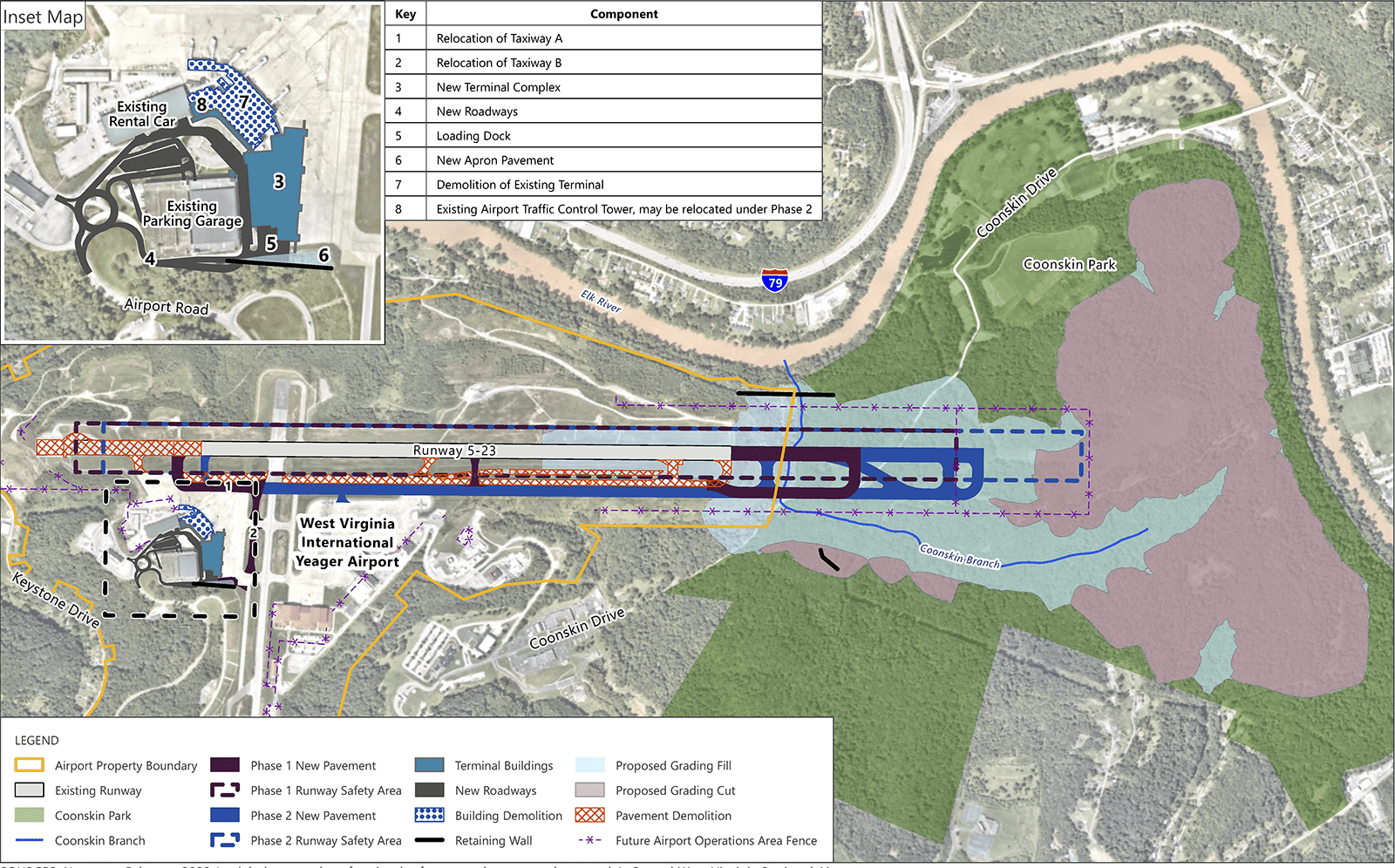PUBLIC MEETINGS
To provide additional information on both the EIS pause and a revised terminal concept, the FAA held two meetings for the public and interested agencies. The meetings were held on Tuesday, July 9, 2024, one from 2:00 p.m. to 4:00 p.m. and another from 6:00 p.m. to 8:00 p.m. Eastern Time at the Embassy Suites by Hilton Charleston Hotel located at 300 Court Street, Charleston, West Virginia. The meetings were conducted in an open house format with project information displayed and representatives from the FAA, the CWVRAA, and the project team available to answer questions.
The meeting materials made available at the meetings will be uploaded to this website under “Past Events.”
FAA PLACES THE EIS ON PAUSE
The Central West Virginia Airport Authority (CWVRAA or Airport Authority) is revisiting the project planning for the proposed runway extension that is contemplated in the Environmental Impact Statement (EIS). As such, the Federal Aviation Administration (FAA) has decided to place the EIS on pause until additional planning work can be completed. The FAA and/or CWVRAA will notify the public and stakeholders should environmental review of the runway project be re-initiated. Proposed projects that can demonstrate independent utility from the runway improvements may be considered in a separate National Environmental Policy Act (NEPA) review in the future.
FAA ISSUES NOTICE OF INTENT FOR THE CRW AIRFIELD, SAFETY, AND TERMINAL IMPROVEMENT PROJECT
On September 30, 2022, the FAA published a Notice of Intent (NOI) in the Federal Register to prepare an EIS and to request scoping comments for the West Virginia International Yeager Airport (CRW) Airfield, Safety, and Terminal Improvement Project (Proposed Action), as proposed by the CWVRAA. The FAA is the lead federal agency for preparation of the EIS and will do so in compliance with the National Environmental Policy Act of 1969 (NEPA), as amended (42 United States Code [U.S.C.] § 4321 et seq.) and Council on Environmental Quality (CEQ) Regulations for Implementing the Procedural Provisions of NEPA (40 Code of Federal Regulations [CFR] Parts 1500-1508). The preparation of the EIS will follow FAA policies for implementing NEPA published in the most recent versions of the applicable agency orders, including FAA Order 1050.1F, Environmental Impacts: Policies and Procedures, and FAA Order 5050.4B, NEPA Implementing Instructions for Airport Actions. The FAA has also invited federal, state, and local agencies to participate as cooperating and participating agencies. The complete list of cooperating and participating agencies for the EIS are identified under Agencies Involved.
PUBLIC SCOPING MEETINGS
The FAA held two in-person public scoping meetings on November 2nd and November 3rd, 2022, from 6:00 p.m. to 8:00 p.m. Eastern Time, at the Embassy Suites by Hilton Charleston Hotel located at 300 Court Street, Charleston, West Virginia. The meetings were conducted in an open house format with project information displayed and representatives from the FAA, the CWVRAA, and the project team available to answer questions. Written and oral comments were accepted at the meetings. The public meetings were open and free to all persons to attend.
The FAA also hosted a virtual public workshop for the proposed Project on Monday, November 7, 2022, from 6:00 p.m. to 8:00 p.m. Eastern Time via Zoom. During the workshop, the FAA provided a welcome and project overview. The FAA then addressed questions about the proposed project and the EIS process. Registered participants were able to submit questions via the Zoom virtual meeting platform. Non-registered participants had the opportunity to submit questions through the FAA YouTube and Facebook Live social media broadcast. Questions about the project from the workshop will not be included as a part of the public record and formal public comments were not taken during the workshop. Participants were encouraged to submit written comments via email, website, or mail.
The meeting materials made available at the meetings were uploaded to this website under “Past Events.”
PROJECT BACKGROUND
The CWVRAA, as the owner and operator of CRW in Charleston, West Virginia, is proposing to construct various airfield, safety, and terminal improvements. To separately satisfy immediate (near-term) needs and long-term needs of the Airport, the proposed improvements would be developed in phases. In the near-term (Phase 1), the CWVRAA proposes to shift and extend Runway 5-23 to the northeast (Runway 23 end) to allow for a Runway Safety Area (RSA) that meets FAA standards on both ends of the runway and to meet existing and forecast future runway needs of 7,000 feet. The CWVRAA also seeks to construct a new terminal complex that would provide modern amenities allowing for a better passenger experience and address terminal area inefficiencies that include an aging and poorly configured terminal facility. Additionally, CWVRAA seeks to relocate taxiways adjacent to the terminal area that are not consistent with FAA design standards.
For long-term needs (Phase 2), the CWVRAA proposes a further shift and extension of Runway 5-23 to provide an 8,000-foot runway, relocation of the remaining portions of Taxiway A that do not meet FAA design standards, development of an additional gate at the terminal facility, and the potential relocation of the existing Airport Traffic Control Tower (ATCT). However, based on the long-term nature of these components, they are not yet considered “ripe for decision,” and will be analyzed at a programmatic level in the EIS.
This website is intended for use by the general public in obtaining information about the EIS process and study and is updated as additional information becomes available. For project updates, please Subscribe to the email list.



